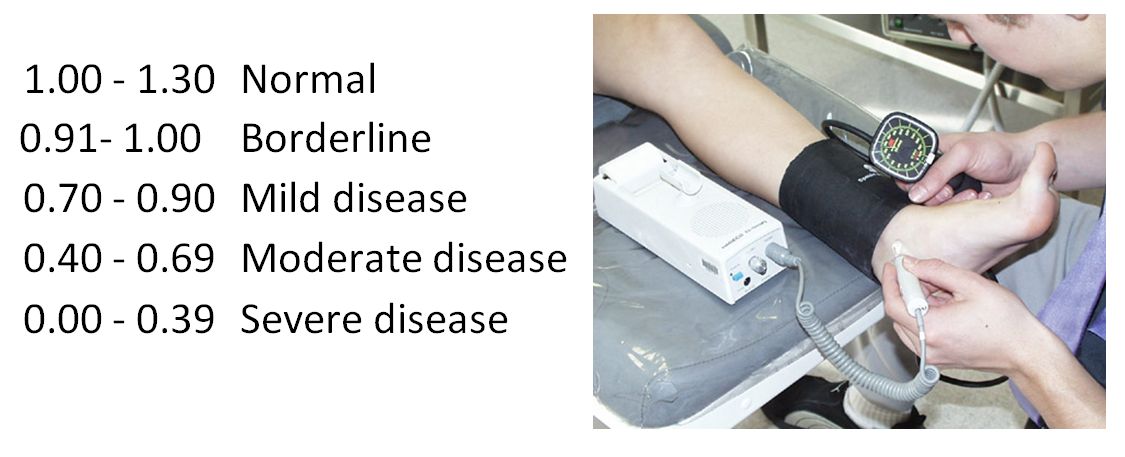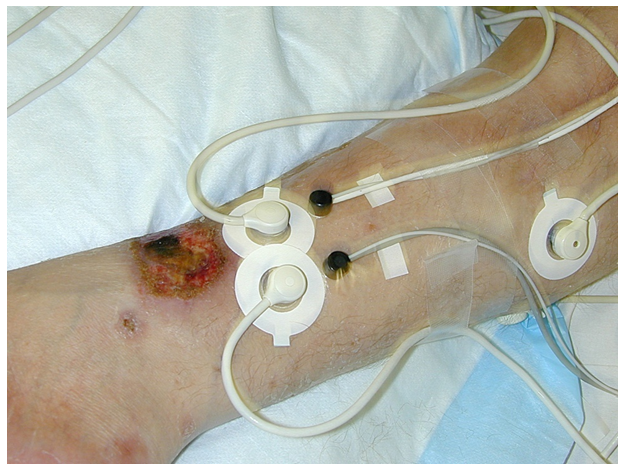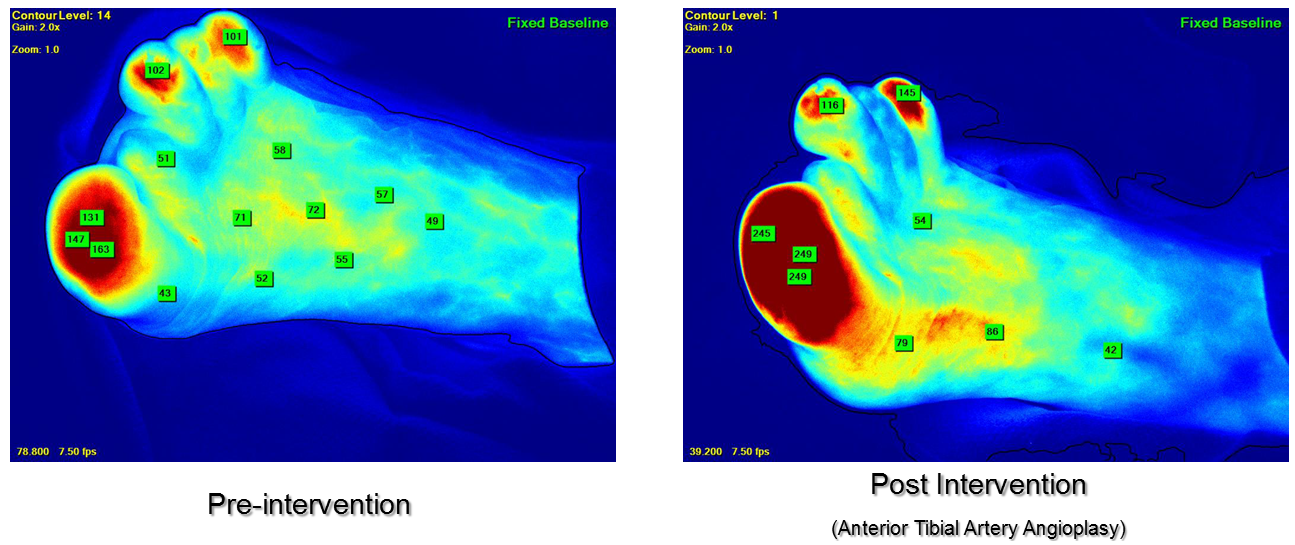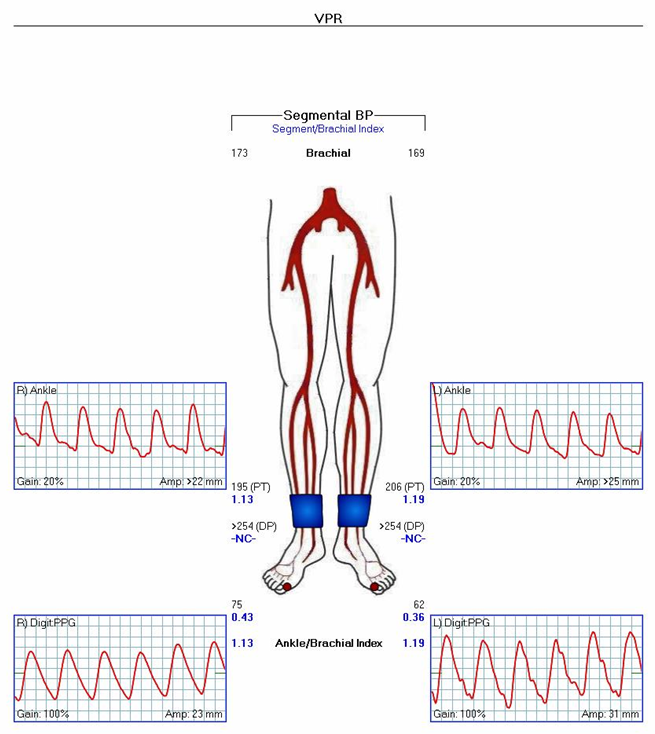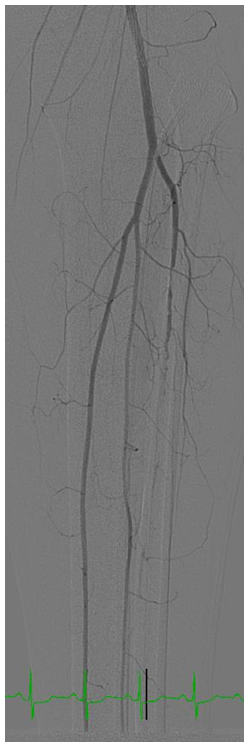Perfusion Assessment in Critical Limb Ischemia
The primary goals in treating individuals with critical limb ischemia (CLI) are to prevent amputation, relieve rest pain, and minimize the risk of death, stroke, and myocardial infarction. Arterial revascularization by an open or endovascular approach has been shown to reduce the risk of amputation among individuals with ischemic ulcers.1 While a number of conditions may cause lower extremity ulceration, adequate perfusion remains an important rate-limiting step to complete wound healing.2 Therefore, accurate perfusion assessment is paramount to making the right diagnosis, offering appropriate revascularization, and allowing proper follow-up post revascularization.
The ankle brachial index (ABI) remains the primary tool to assess vascular disease in patients with peripheral artery disease (PAD) and CLI (Figure 1).3 It is obtained by dividing the systolic pressure in the dorsalis pedis and posterior tibial artery by the higher of the two brachial artery measurements. Therefore, two ABIs on each ankle are obtained; however, only the higher of the two ABIs is usually reported per the guidelines.3 In general, ABI has been divided to borderline, mild, moderate, and severe with the latter two considered as significant for lower extremity ischemia (Figure 1). While an abnormal ABI is very informative, a normal or near normal ABI does not exclude ischemia in patients with CLI and lower extremity wounds.4 Recently, we showed that about 30% of patients with CLI present with isolated below knee disease, and these individuals have borderline or normal ABI.4 ABI has other limitations: ABI evaluates perfusion to the ankle and not distal foot, thereby providing perfusion assessment in macrovascular system (tibial arteries) and not microvascular vessels (foot, arch, and capillaries). Because of some of these limitations, many investigators have advocated the toe pressure or toe-brachial index (TBI) as an adjunctive perfusion tool to be used in patients with CLI. In general, a toe systolic pressure of <60 mm Hg or a TBI <0.71 is considered abnormal for proper wound healing and is indicative of significant ischemia.4
|
In addition to ABI and TBI, other modalities have been used to assess perfusion in patients with CLI. Transcutaneous oxygen saturation (TcPO2) measures oxygen tension 1-2 mm deep in the skin from local capillary perfusion.5 A value of <40 has been associated with higher amputation and is usually indicative of ischemia requiring further evaluation (Figure 2). TcPO2 is also used to assess hyperbaric oxygen response in patients with lower extremity wounds. Unfortunately, this technology has a number of limitations, including significant procedure time, and is affected by high altitude, pulmonary disease, heart failure, lower extremity edema, and skin thickness.
|
Skin perfusion pressure (SPP) is another tool used to assess perfusion. A cuff is placed at the level of metatarsal bone and inflated until no Doppler sounds are heard. It is then slowly deflated while using a laser Doppler, the pressure at which movement in the capillaries are detected is captured. A value <40 is considered significant for poor wound healing. Bothe SPP and TcPO2 are useful adjunctive modalities to assess perfusion; however, TcPO2 is limited due to issues outlined above including cumbersome test duration.6
There are other modalities that are currently under research investigation to assess perfusion to the foot. One of these intra-operative fluorescence angiography can potentially assess capillary perfusion using indocyanine green (ICG) fluorescence tracer. This compound binds to plasma protein and is cleared by the hepatic system (Figure 3). It has been used in breast reconstruction and open heart surgery.
|
Perfusion assessment remains the cornerstone of diagnosis and follow-up in patients with LI. Newer technologies should provide easier tools to assess perfusion in patients with CLI. In the meantime, a personalized approach that relies on physiologic and anatomic variables should help provide accurate perfusion assessment.7 While ABI is important, in about 30% of patients, it may be falsely normal or near normal.4 Reliance on other tools such as TBI, TcPO2, and SPP in these circumstances is important but clinical acumen and wound healing should drive all treatments (see case example in Figures 4a, b, c).
|
References
- Anderson JL, Halperin JL, Albert NM, et al. Management of patients with peripheral artery disease (compilation of 2005 and 2011 ACCF/AHA guideline recommendations): a report of the American College of Cardiology Foundation/American Heart Association Task Force on Practice Guidelines. J Am Coll Cardiol 2013;61:1555-70.
- Goodney PP, Beck AW, Nagle J, Welch HG, Zwolak RM. National trends in lower extremity bypass surgery, endovascular interventions, and major amputations. J Vasc Surg 2009;50:54-60.
- Rooke TW, Hirsch AT, Misra S, et al. 2011 ACCF/AHA focused update of the guideline for the management of patients with peripheral artery disease (updating the 2005 guideline): a report of the American College of Cardiology Foundation/American Heart Association Task Force on Practice Guidelines. J Am Coll Cardiol 2011;58:2020-45.
- Bunte MC, Jacob J, Nudelman B, Shishehor MH. Validation of the relationship between ankle-brachial and toe-brachial indices and infragenicular arterial patency in critical limb ischemia. Vasc Med 2015;20:23-9.
- Brooks B, Dean R, Patel S, Wu B, Molyneaux L, Yue DK. TBI or not TBI: that is the question. Is it better to measure toe pressure than ankle pressure in diabetic patients? Diabet Med 2001;18:528-32.
- Intersocietal Accreditation Commission Standards and Guidelines for Vascular Testing Accreditation (Intersocietal Accreditation Commission website). 2012. Available at: http://www.intersocietal.org/vascular/standards/IACVascularTestingStandards2015.pdf. Accessed: 9/4/2013.
- Bunte MC, Shishehbor MH. Treatment of infrapopliteal critical limb ischemia in 2013: the wound perfusion approach. Curr Cardiol Rep 2013;15:363.
- Shishehbor MH, Reed GW. Personalized approach to revascularization of critical limb ischemia. Circ Cardiovasc Interv 2014;7:642-4.
Keywords: Altitude, Amputation, Ankle, Ankle Brachial Index, Ankle Joint, Blood Gas Monitoring, Transcutaneous, Blood Pressure, Blood Proteins, Brachial Artery, Capillaries, Cardiac Surgical Procedures, Edema, Fluorescein Angiography, Fluorescence, Follow-Up Studies, Foot, Goals, Heart Failure, Humans, Hyperbaric Oxygenation, Indocyanine Green, Ischemia, Lung Diseases, Male, Mammaplasty, Metatarsal Bones, Myocardial Infarction, Oxygen, Pain, Peripheral Arterial Disease, Research Personnel, Stroke, Tibial Arteries, Toes, Ulcer, Wound Healing
< Back to Listings

